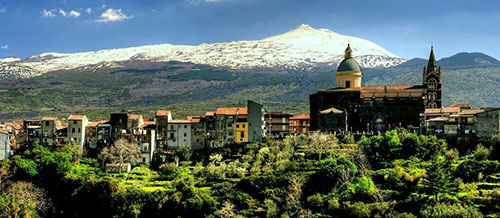
|
Randazzo (765 m asl) is a historical and cultural center of remarkable interest: although it is the closest town to the crater (15 km) built on a prehistoric lava bench on the watershed between the basins of Alcantara and Simeto, it survived to the eruptions over the centuries, retaining most of its medieval charm with buildings built of lava stone.
Founded by the Byzantines, it became important during the Swabian-Aragon period and in 1305 it was chosen by Frederick II of Aragon as his summer residence. Its culture is based on the influx of three different populations (Greek, Latin and Lombard) it had a church for each ethnic group (Santa Maria, St. Nicholas and St. Martino) as a Mother Church. During the Second World War Randazzo was the location of the final defeat of the German troops in Sicily. Rich in unique historic and architectural elements; the most important building is the basilica of Santa Maria (Cathedral): it is a Norman-Swabian lava stone building, built between 1217 and 1239, which went through changes in the 16th and in the 19th century. The original structure is kept in the apses with a shape of embattled towers; the elegant bell tower leans against the façade: both were rebuilt in the 19th century. Within the basilica there are many frescoes and important paintings (the most ancient date back to the seventeenth century). The Church of St. Nicholas preserves the early fourteenth century structure even if it was rebuilt at the end of the 16th century: it looks like a fortress and is the largest church in the city. Inside there are numerous works of religious art of the Sicilian school, with several works by Antonello and Giacomo Gagini. Finally, the Church of St. Martino dating back to the thirteenth century has a seventeenth-century façade and a fourteenth-century bell tower; inside it has 3 naves aisles full of works of art of the fifteenth and sixteenth centuries. The Scala Palace was the residential Royal Palace, yet unfortunately it went through many changes; it hosted Charles V and was damaged by the earthquake of 1693. The Swebian Castle is shaped like a squat four-sided tower with battlements; it was part of the medieval citadel which was used as a prison in the 16th century. Today it houses the Vagliasindi Archaeological Museum, in the S.Anastasia district which features an interesting collection of archaeological items, and the Museum of Sicilian Puppets, with an interesting collection of 21 Sicilian Puppets in the Catania style that were used to narrate the tales of Charlemagne and the Paladins. |


